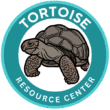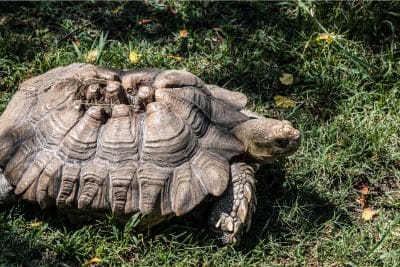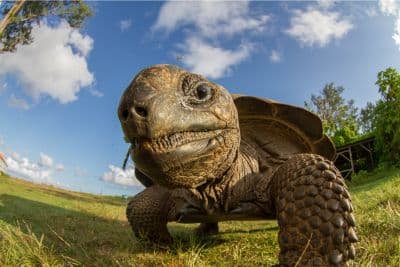In many respects, tortoises make undemanding pets. As long as you start with a healthy animal and provide him with an appropriate habitat and care, your pet will likely live a long and healthy life.
However, even tortoises that receive nearly perfect care can occasionally develop health problems or exhibit signs of illness. One of the most common examples of this is inappetence. This is where some tortoises simply stop showing any interest in consuming food.
This can be a serious issue – obviously, tortoises need to consume food to live. However, there are a variety of strategies keepers can implement to help encourage their pet to resume feeding normally.
To help put your mind at ease, in this article, I’ll be laying out some of the most common reasons tortoises stop eating and sharing a plan of attack for addressing any issues that may arise.
- How Often Should Tortoises Eat?
- Reasons Tortoises May Stop Eating
- Is Your Tortoise not Eating? Here's What to Do
- 1. Make a few dietary changes.
- 2. Consider the time of year.
- 3. Consider the possibility that your tortoise is interested in breeding or depositing eggs.
- 4. Consider stress-related causes.
- 5. Inspect your tortoise for obvious signs of injury or illness.
- 6. Check the enclosure temperatures.
- 7. Check the enclosure humidity level.
- 8. Check the enclosure lighting.
- 9. Clean the entire enclosure and remove the substrate.
- 10. Contact your veterinarian.
- Citations
How Often Should Tortoises Eat?
Before you start worrying that your tortoise has stopped eating, it’s worth considering the frequency with which tortoises should eat. This will vary slightly based on the age of your tortoise, as well as from one individual to the next.
Most healthy tortoises should be interested in eating once every day or two. A large meal may satiate a tortoise for a full day, but he should begin showing interest in food again within about 48 hours.
However, there are a few caveats to this.
Tortoises may show no interest in food at all if they begin feeling the need to brumate (the reptilian version of hibernating) or aestivate (a similar phenomenon but carried out during hot and dry weather). This may even begin a few weeks before the temperatures change.
Similarly, tortoises who’re focused on mating or depositing eggs may show no interest in food either. However, most will begin to eat again (often ravenously) once they’ve deposited eggs or their urge to mate passes.
Reasons Tortoises May Stop Eating
If you are certain that your pet doesn’t feel the need to brumate or aestivate, and reproductive motives aren’t overshadowing his appetite, you can be reasonably sure that something is wrong. It may be a health issue, but it could also be related to the care you’re providing.
Some of the most common reasons that tortoises begin refusing food include:
- Respiratory Infections: Respiratory infections in tortoises are often much more serious than they are in humans. They can not only make your tortoise feel generally unwell, but they can also make breathing difficult, which can reduce his overall energy level.
- Intestinal Parasites: Internal parasites don’t often cause problems when their numbers are limited, but large parasite loads can take up a lot of space in the digestive tract, thereby reducing your pet’s appetite.
- Gastrointestinal Infections: Gastrointestinal infections can cause your tortoise to feel nauseous or suffer from diarrhoea, which will diminish his appetite. They may even cause generalized gastrointestinal tract pain, which may also make him refuse food.
- Suboptimal Temperatures: Low temperatures will often cause a tortoise’s metabolic rate to slow, which will, in turn, reduce his appetite.
- Inappropriate Enclosure Humidity: Occasionally, excessively dry conditions will cause tortoises to refuse food.
- Stress: One of the leading causes of inappetence, stress will not only cause a tortoise to stop eating but also exhibit poorer immune response.
- Metabolic Disorders: Over the long-term, inappropriate diets can cause tortoises to suffer metabolic disorders. Unfortunately, these are rarely easy to address, and they will cause much more significant problems than simple food refusal.
- You’re Providing Inappropriate Food Items: Some tortoise species prefer one type of plant material to the exclusion of others, and individual tortoises often exhibit varying preferences.
- Constipation or Intestinal Obstruction: When a tortoise’s food isn’t moving properly through his digestive tract, he may feel less inclined to eat.
- Injuries: While injuries don’t often lead to food refusal, they can at times. This is particularly true of injuries that affect the mouth or digestive tract.
- Inadequate Enclosure Lighting: Poor UVB light levels can affect your tortoise’s mood and compromise his ability to recognize food.
This list is certainly not exhaustive. A litany of issues may cause a tortoise to refuse food. However, these are certainly among the most common, and they should be the first things you discuss with your vet.
Is Your Tortoise not Eating? Here’s What to Do
Often, you’ll find that there are several possible reasons your tortoise has ceased eating. Accordingly, it is important to take a methodical approach to addressing the problem.
While you may need to adjust this sequence based on the idiosyncrasies of your specific situation, we’ll share a good outline for a plan below. As you’ll see, it begins with relatively simple steps, before moving on to more complicated tasks.
1. Make a few dietary changes.
Tortoises have individual tastes, which is something you’ll always want to remember. This tortoise may love carrots; that tortoise may prefer dandelions. Additionally, tortoises can grow tired of some food items or simply exhibit a change in tastes.
So, begin by offering your tortoise different food items. If you already know your pet has a particular fondness for a given food, start with that. You may also want to try some of the things many tortoises enjoy, such as melon, strawberries, or grapes.
Note that these things shouldn’t form the bulk of your tortoise’s diet. But they can be helpful for getting things back on the right track.
2. Consider the time of year.
Many tortoises will begin refusing food in the late fall, and they’ll continue to do so throughout the winter months. This is rarely cause for concern, but it does mean you may need to implement a brumation period, as fasting tortoises who’re kept at high temperatures will lose weight.
Aestivation isn’t as common in captivity, but you should consider the enclosure conditions if fasts occur during the summer. If the temperatures have been unusually hot or dry, you may want to take steps to increase the humidity level. This may help convince your tortoise to resume eating.
3. Consider the possibility that your tortoise is interested in breeding or depositing eggs.
If your tortoise is interested in mating, he may exhibit a reduced desire to eat. This isn’t particularly common among female tortoises, but they will often start refusing food as the time of egg deposition nears.
This means that you should always consider whether mating impulses are disrupting your tortoise’s desire to feed.
Are You Starving Your Tortoise?
Save 10% on premium tortoise food and supplements from Tortoise Resource Center on Amazon now using code BUYNOWGET10
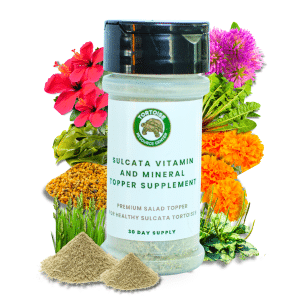
Sulcata Vitamin & Mineral Topper Supplement
30-Day Supply | 2 oz (56 g)
$24.99
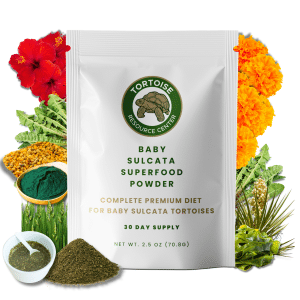
Baby Sulcata Tortoise Superfood Powder
30-Day Supply | 2.5 oz (70.8 g) Bag
$24.99
4. Consider stress-related causes.
Stress is one of the most frequent causes of food refusal in tortoises. Common sources of stress include inappropriate enclosure temperatures or humidity levels, a lack of hiding or burrowing opportunities, and overly frequent interactions with keepers. Dogs, cats, or other pets may also lead to stress, as can cage mates.
Try to identify the source of your tortoise’s stress and then take steps to alleviate it. For example, if you suspect that your tortoise doesn’t have enough hiding places, you could add a few more to the enclosure. However, try to avoid making drastic changes to your pet’s enclosure or daily life, as this itself can lead to additional stress.
5. Inspect your tortoise for obvious signs of injury or illness.
Sometimes, a tortoise will exhibit physical signs or symptoms that are related to his diminished appetite. For example, you may note a runny nose or labored breathing, which may be indicative of a respiratory infection. Similarly, you may notice that your tortoise has a large wound on his plastron, which could be related to his recent food refusals.
So, be sure to give your tortoise a full visual inspection to identify any clues. Just be sure to do so in the gentlest, calmest manner possible, to help avoid causing him more stress. If you notice any signs or symptoms of a health problem, go ahead and contact your veterinarian promptly.
6. Check the enclosure temperatures.
Because tortoises are ectothermic (“cold-blooded”) animals, they may lose their appetite if temperatures fall below their preferred range.
The specific temperature range your tortoise needs will vary based on its species, but most tortoises thrive best when provided with a basking spot of between 90 and 100 degrees Fahrenheit. Also, be sure that your tortoise has access to a variety of temperatures inside the enclosure (a thermal gradient), so that he can adjust his temperature by moving around the habitat.
If the temperatures are not within this range, take steps to rectify the issue. You may need to change heat lamp set-up such as adjust the wattage of the heat lamp bulbs you’re using, add additional heat lamps, or install some enclosure insulation to do so.
Note that it may take your tortoise several hours to warm up sufficiently and regain his appetite once you’ve addressed the temperature problem.
7. Check the enclosure humidity level.
Sub-optimal humidity levels can cause tortoises to feel uncomfortable, which can cause them to refuse food. This can occur with any species, but it is most common among tortoises that hail from rainforests.
The preferred humidity range for different tortoise species ranges from about 30% to 80%, so you’ll simply have to research the needs of your specific pet to determine the ideal humidity level. Once you do, add water to the enclosure by misting the substrate, pouring small amounts of water directly into the substrate, or by switching to a larger water dish.
Humidity levels typically rise slowly, so it may take some time to restore your pet’s appetite.
8. Check the enclosure lighting.
Dim or poor-quality light can influence your tortoise’s mood and may even prevent him from properly recognizing some items as food. So, start by ensuring that your tortoise’s enclosure is bright and well-lit.
Additionally, check your records to see when the last time you changed his full-spectrum lighting was. If it was more than six months ago, it is probably a good idea to replace the old lights with new ones (the UV output of lights diminishes over time). If your lights are relatively new, you may want to consider measuring their UV output with a light meter.
Fortunately, tortoises who stop eating because of insufficient light quality will often resume feeding in quick order once proper lighting is provided.
9. Clean the entire enclosure and remove the substrate.
Cleaning the enclosure and replacing the substrate is unlikely to trigger your pet to resume feeding in itself; instead, it will allow you to start preparing for the next step.
At this point in the process, you’ve likely been able to rule out many of the easy-to-fix issues. This means that you’ll need your veterinarian’s help. Cleaning the enclosure thoroughly is simply a good practice anytime you may be faced with a sick tortoise – some bacteria, fungi, and parasites can cause health problems for your tortoise if they build up to harmful levels inside the enclosure.
Additionally, one of the things your veterinarian will likely request that you do is collect a fecal sample. This is difficult to accomplish when using natural substrates, such as soil or mulch. So, you’ll want to temporarily switch to a newspaper substrate, as this will allow you to collect a sample more easily.
10. Contact your veterinarian.
As referenced in the preceding step, you’ll likely need your veterinarian’s help at this point. So, set up an appointment and allow your vet to examine your tortoise.
Your vet will likely review your husbandry practices, enclosure design, and diet, and then take a history, meaning that he or she will ask you about the onset of symptoms and things you’ve noticed. From there, your vet may decide that tests are necessary. These may include a blood draw, fecal analysis, or imaging (X-rays, ultrasounds, etc.).
Once your vet has determined the most likely cause of your tortoise’s inappetence, he or she will outline a suitable treatment. This may include medications or even surgery, if the cause is an impaction.
Citations
- Star Tortoise Garden – Indoor UVB Lighting
- Crossriggs Veterinary Clinic – Parasitic Infectious Diseases in Tortoises
- Florida Fish and Wildlife Conservation Commission — Upper Respiratory Tract Disease (URTD)
